Moena isn’t a ski-in, ski-out resort. But it is a short drive from several separate areas of superb pistes, set amidst stunning scenery in the Italian Dolomites. For those who don’t mind day-tripping to the slopes, it offers high-quality skiing and an authentic mountain atmosphere at a very reasonable price.
Altitude: 1184m
Top lift: 2949m
Ski area: 1200km in Dolomiti Superski
Adult lift pass: €229-287 for six days
Official Site |
Ski Map |
Webcam
Resort Overview
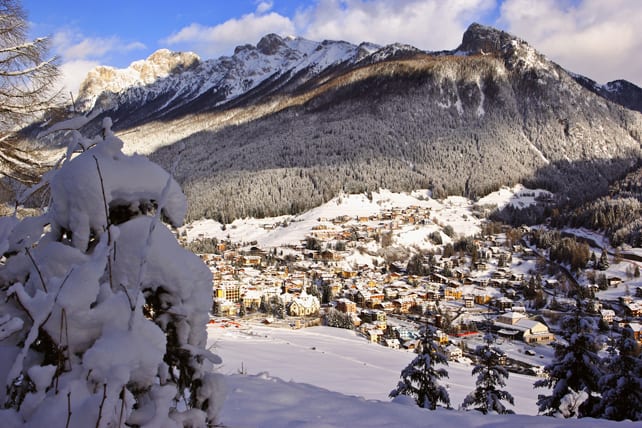
Do you ever go skiing in the Alps and wonder – where have all the real people gone? Or – is there anything more interesting to eat than fondue or chicken and chips? Or – why can’t I get a decent bottle of wine at lunch for less than 30€?
If you do, then consider Moena for your next ski holiday. It’s a small town, set at the southern end of the Val di Fassa in the Italian Dolomites, on the road up to Canazei. It’s not ski-in, ski-out, but the nearest slopes are only ten minutes away, and they’re home to a several first-class pistes, backed by stunning Dolomite scenery. There are many more ski areas within easy commuting distance – the famous Sella Ronda circuit is among them. But the real treat here lies in skiing areas no-one’s heard of and which are, on weekdays, blissfully quiet.
Crucial to the appeal of Moena and the Val di Fassa are their cuisine and culture. Good food and wine are much cheaper here than they are in the A-list resorts – and the local specialities are far more interesting than the usual cheese-with-everything schtick.
In part that’s because the locals have such a strong sense of their own identity. Culture here isn’t some ersatz confection, planted in the middle of a high mountain bowl by property developers. The Val di Fassa is one of the strongholds of the Ladin people – a 40,000-strong minority, spread across the Dolomites, who have managed to preserve their language into the 21st century. It’s derived from colloquial Latin and a language that predates the Romans, and it’s proving remarkably durable.
To get the best from Moena and the Val di Fassa, you’ll need a car – and a sense of adventure. But if you’re looking for a sense of place, with reasonable prices and sumptuous on-piste skiing; and you’re prepared to research and organise your own travel and accommodation, then you’ll find them a rewarding destination for a ski holiday.
A short guide to the skiing at Moena and in the Val di Fassa
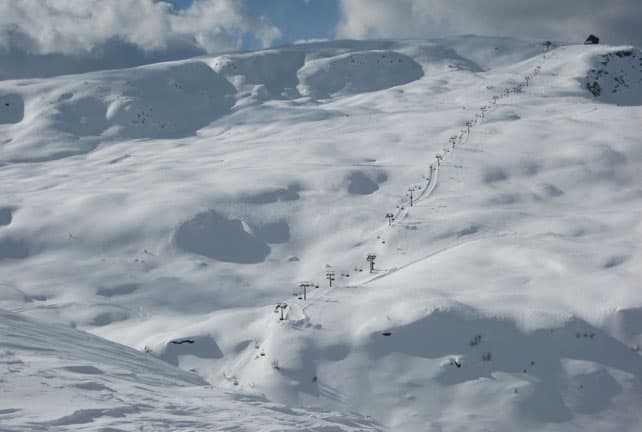
Moena is close to several compact areas of top-notch pistes. On its own, none is enough to justify the trip, but together they build into a compelling argument. Immaculately groomed, backed by gorgeous Dolomite scenery, and all but deserted on weekdays, these are the kind of pistes you always dream of skiing, but rarely find. It’s not often in the Alps that you can really lean into your edges and carve across a piste without worrying you’re going to collide with a skier holding a straighter line. But on the slopes above Moena, it’s perfectly normal.
One caveat: we wouldn’t suggest coming here after the middle of March. The climate in the Dolomites is fairly cold and dry. It’s the perfect climate for snow cannons: and the resorts of the Val di Fassa (and the Val di Fiemme, next door), are masters of the snow-maker’s art. So even if there hasn’t been much natural snow, the pistes are usually covered with soft, grippy snow. In fact, on-piste, it’s hard to tell the difference between man-made snow and the stuff that falls from the sky. But all the same, spring comes on quickly here, and there isn’t much skiing on offer above 2500m.
Check out the map below for an idea of all the skiing on offer along the Val di Fassa. They’re all covered by the Dolomiti Superski pass, but you can also buy passes to individual areas separately. The savings are small, and only worth making if you’re sure you won’t venture further afield.
View Map of ski areas in the Val di Fassa and Val di Fiemme in a larger map
The nearest area to Moena is the Trevalli – a ten minute drive from the village. It encompasses 100km of pistes in three separate areas, all of which are worth exploring. They contain some lovely descents – notably, the long, long blue down to the Zirma, the swooping black to the cable car at Ronchi, and the red from the Col Margherita to the Passo Pellegrino. In the middle of the week, these pistes are all but deserted: in a place like Courchevel you’ll only enjoy on-piste skiing like this in the first 15 minutes of the day, before everyone else hits the slopes.
Here’s a rather nifty “3-D” graphic showing the extent of the pistes:
ARVE Error: For the maxwidth (maxw) option you need to have normal or lazyload mode enabled, either for all videos in the plugins options or through shortcode e.g. [youtube id=123456 mode=normal maxw=999 ].
You should also make time to visit the Ski Center Latemar. There’s lift access from Predazzo, just south of Moena. As an area, it’s a good bet in flat light because so many of the pistes are tree-lined. But it’s also home to some classic pistes – gorgeous, fast carving tracks, with a couple of steep blacks thrown in to get you thinking about your technique.
ARVE Error: For the maxwidth (maxw) option you need to have normal or lazyload mode enabled, either for all videos in the plugins options or through shortcode e.g. [youtube id=123456 mode=normal maxw=999 ].
You can also have a great half-day bombing about in the Ciampedie/Catinaccio ski area, just north of Moena – as a warm-up before lunch at the gorgeous mountain restaurant, Baita Checco. Beyond that point lie the slopes above Canazei and Pozza di Fassa, covered in our Canazei resort report.
Ski School in Moena and the surrounding areas
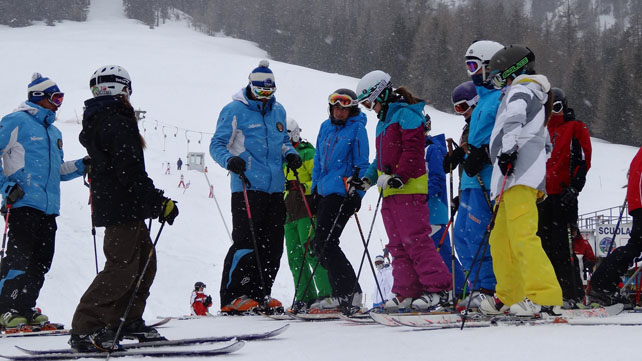
There are two ski schools in Moena. The official Italian ski school Moena-Dolomiti is the biggest, and offers group and private lessons at both Alpe Lusia and at the Passo San Pellegrino.
The Associazione Maestri Sci Moena is a group offering ski lessons only at Alpe Lusia.
For a five day course of group ski lessons, prices are comparable to those in France and Austria, though you get more hours for your money than France. (In case you’re wondering, Switzerland is the most expensive place to get tuition, thanks to the strength of the Swiss franc).
But the cost of private ski lessons is much lower. Two hours with an instructor for two people is less than two thirds of the price you’d pay with a British ski school in the likes of Meribel.
We’d strongly recommend booking private lessons. Group lessons can be lots of fun of course: but the problem for Brits in Moena is the lack of English-speaking classmates in group ski lessons (most clients are German, Czech, Polish or Italian). By booking a private instructor (and insisting you’re assigned one who speaks good English), you’re not going to have bilingual lessons, and you’re also going to get a more informal atmosphere, as well as lots of individual attention. You’re skiing will improve much more quickly as a result.
What’s more if there’s four of you in your private group, it’s almost cheap. At 2017 prices, two hours would cost roughly €35pp – which means you could have five days of private instruction for the same price as group lessons.
Where to Stay in Moena
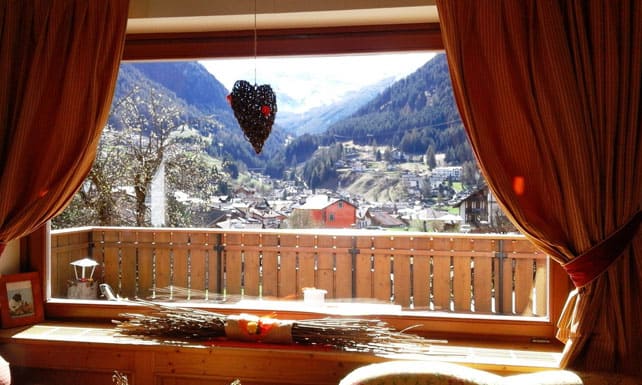
Where to stay in Moena? Most of the accommodation is in small or mid-sized family hotels – which are refreshingly underpriced when compared with A-list resorts in France or Austria. Room sizes tend to be larger than average – but expect cutting-edge design or state-of-the-art facilities.
The town itself is pretty, and was vastly improved a few years ago when a new bypass was built. Gone are all the buses and lorries which used to rumble through Moena’s main street on the way to the larger resorts at the far end of the valley: and the authorities even close the tow to local traffic between 5 and 7pm, and again after dinner, so it’s completely pedestrianised, and the perfect setting for the evening passeggiata. Clearly, the intention is to turn it into a gilded holiday resort – but the job isn’t done yet, and it still feels like a proper town, with a life beyond chair-lifts and ski hire.
At the three-star level, the pick of the properties is the recently-refurbished Hotel Cavalletto in the centre of town – blessed with a painstaking owner and boasting a rather chic wellness area. Slightly out of the town centre the three-star Romantica is another good option: pretty, family-run and recently refurbished. It also has lots of parking space. However, if you like wandering around the shops and bars in the evening, the Cavalletto is a better option.
At four stars, we like the Hotel Dolomiti, which has big rooms and a good chef: although dinner is a tad formal for British tastes. A particularly welcome feature is the array of cakes they lay on at tea-time for their guests, at no extra charge. It’s close to the centre of town, so great for an evening stroll, and there’s enough parking at the back for guests.
Where to Eat in Moena
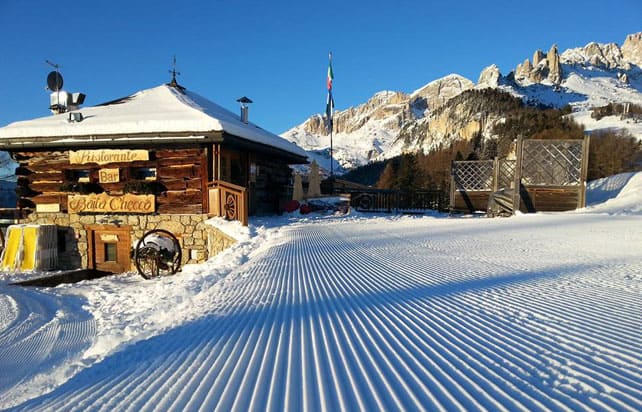
Half the point of coming to Moena and the Val di Fassa is to eat well – both on and off the mountain. A rich array of local ingredients, excellent wines from the Adige Valley, and the rich mix of cultures – Ladin, Austrian and Italian – have created a top-notch culinary scene, which is nowhere near as expensive as you’ll find in the French Alps. Once you’ve sampled it, you’ll wonder how you ever settled for the usual melted-cheese-with-everything schtick further north.
The star of the lunchtime scene is the Baita Checco, in the small but stunning ski area of Ciampedie/Cantinaccio. There chef Matthias Trottner cooks local ingredients superbly – amongst the many highlights are orzotto (like a risotto, but made with barley), polenta with sausage and porcini mushrooms, and slow-cooked veal.
Meanwhile, on the slopes above the Passo San Pellegrino the Baita Paradiso is the place to aim for. It’s the way all self-service restaurants should be run – with bread (and pizza bases) made fresh on the premises each day, and gnocchi and pasta cooked fresh to order while you wait. Chef Gino Defrancesco is the brains behind the operation: “Yes you have to be quick in a restaurant like this,” he says. “But that doesn’t mean you have to serve boring food”.
If you’re skiing at Alpe Lusia, chalet Valbona is the place most people head for, with a large sun terrace and a choice of self-service and a more formal restaurant for lunch. It even has an oyster bar. At the Ski Center Latemar, the main gathering point is the Zischgalm is the place everyone congregates, especially if the sun’s out.
For dinner, the two restaurants to target around Moena are Michelin-starred Malga Panna and the Rifugio Fuciade. Rifugio Fuciade is a real treat – an old-fashioned and atmospheric spot which you reach by snowmobile (included in the price of dinner). This is proper gastronomic grub, at roughly half the price you’d pay in France. Specialities include fig ravioli, vension with juniper berries and cream, and the pungent local cheese, puzzone, dipped in spicey mustard-seed chutney. Yummmmmmy!
Apres-Ski in Moena
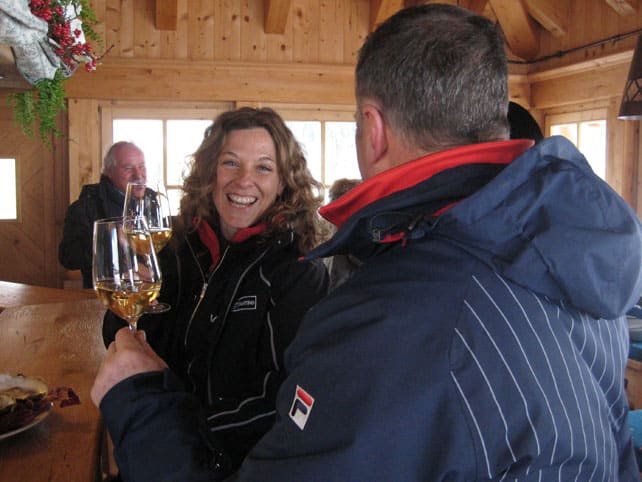
But if you’re idea of a day out includes a Bombardino or two on the slopes, and a glass of the smooth and creamy Ferrari sparkling wine around 3.30pm – then you’re going to have a fine time here.
What’s a Bombardino? A mix of Vov (egg liqueur), whisky and rum, warmed up and topped off with cream – and when one of our editors skied here recently he was told it was the standard mid-morning pick-me-up. On reflection, he’s not sure how ‘standard’ it is at 11am (everyone else in the bar was drinking espresso), but it certainly spiced up the final hour and a half before lunch.
The place to drink Bombardino is in the Alpe Lusia sector of pistes, at a hut called Baita la Morea, on the long blue piste above Zirmo. For fizz, try Chalet Valbona nearby. Make sure it’s Ferrari, not champagne by the way: it’s made locally, near the town of Trento, according to the méthode champenoise, and it’s much better than the standard non-vintage stuff from France.
If you’re skiing over in the Ski Center Latemar, the Zischgalm is the main gathering point for a mid-afternoon drink before heading back down the mountain.
Back in Moena, you’ll find several bars in the evening, pedestrianised zone in town: the Kusk wine bar on three levels, is by far the buzziest of them. But don’t be fooled into the thinking the town is going to burn with the party spirit later on: this is much more about have an aperitivo with friends before dinner.
By the way, the Val di Fassa has recently gained a rather beautiful and serene spa – QC Terme. It’s well worth driving up to Pozza di Fassa, at the far end of the valley to try it out: but book first to be sure of a place.
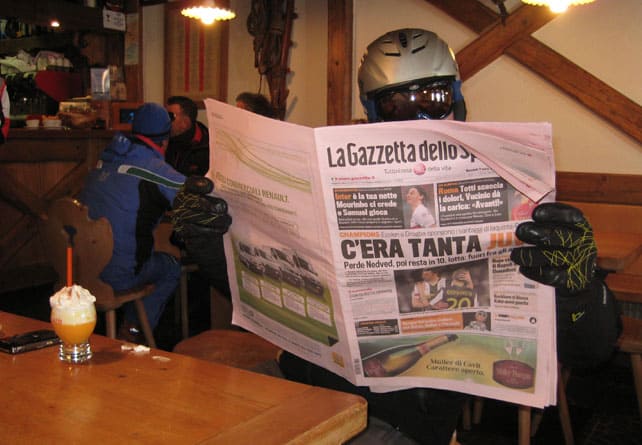










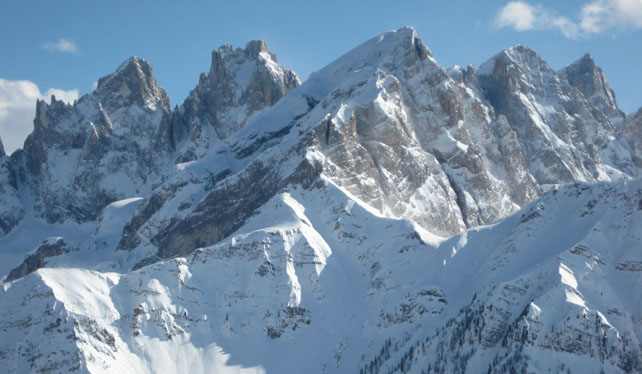
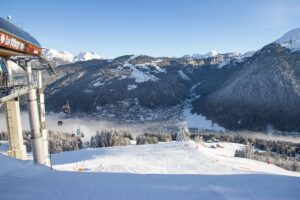
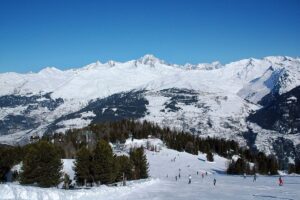
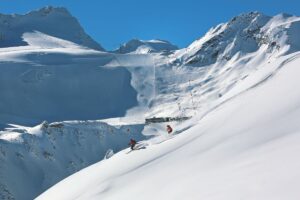
Nicely written! Thank you